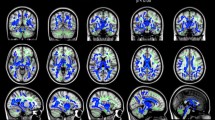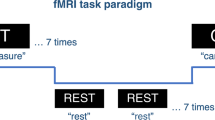Abstract
Within the last 10 years, there has been an increasing interest in the area of neonatal distress and birth trauma. Because new and improved medical equipment and techniques are now available and in use, the survival rate of infants who have suffered some kind of perinatal insult has greatly increased. It has been clear for some time to clinicians that the continuing use of the traditional criteria of mortality/morbidity is no longer appropriate when used in conjunction with the sophisticated technology at their disposal. Standard neurological techniques are poor and identify only the most obvious pathology. More sensitive criteria must be found.
Access this chapter
Tax calculation will be finalised at checkout
Purchases are for personal use only
Preview
Unable to display preview. Download preview PDF.
Similar content being viewed by others
References
Apgar, V. and James, L.S. Further observations on the newborn scaling system. Am. J. Dis. of Child., 104:419–428 (1962).
Bowes, W.A., Brackbill, Y., Conway, E. and Steinschneider, A. The effects of obstetrical medication on fetus and infant. Monographs of the Society for Research in Child Development, 35(4, Serial No. 137) (1970).
Brackbill, Y. The role of the cortex in orienting: Orienting reflex in an anencephalic human infant. Devel. Psychol, 5:195–201 (1971).
Brackbill, Y., Kane, J., Manniello, R.L. and Abramson, D. Obstetric premedication and infant outcome. Am. J. Obstet, and Gynecol, 118(3):377–384 (1974).
Bronstein, A.I., Itina, N.A., Kamenetskaia, A.G. and Sytova, V.A. The orienting reactions in newborn children, in Voronin, L.G., Leontiev, A.N., Luria, A.R., Sokolov, E.N. and Vinogradova, O.S. (eds.), Orienting Reflex and Exploratory Behavior. Moscow: Academy of Pedagogical Sciences of RFGSR (1958).
Conway, E. and Brackbill, Y. Effects of obstetrical medication on infant sensorimotor behavior. Paper presented at a meeting of the Society for Research in Child Development, Santa Monica, March (1969).
Decarie, T.G. A study of the mental and emotional development of the thalidomide child, in Foss, B.M. (ed.), Determinants of Infant Behavior IV. London: Methuen, pp. 167–188 (1969).
Drage, M.S. and Berendes, H. Apgar scores and outcome of the newborn. Pediat. Clin. N. Amer., 13:635–643 (1966).
Fagan, J.F. Infants’ recognition memory for a series of visual stimuli. J. Exper. Child Psychol, 11:244–250 (1971).
Fagan, J.F. An attention model of infant recognition. Child Devel., 48:345–359 (1977).
Fagan, J.F., Fantz, R.L. and Miranda, S.B. Infants’ attention to novel stimuli as a function of postnatal and conceptional age. Paper presented at a meeting of the Society for Research in Child Development, Minneapolis, April (1971).
Fantz, R.L. Visual experience in infants: Decreased attention to familiar patterns relative to novel ones. Science, 146:668–670 (1964).
Friedman, S. Infant habituation: Process, problems and possibilities, in Ellis, N.R. (ed.), Aberrant Development in Infancy. Hillsdale, N.J.: Lawrence Erlbaum, pp. 217–237 (1975).
Gelber, E.R. Habituation, discrimination learning, and visual information processing in infants. Unpublished doctoral dissertation. University of Illinois (1972). (Cited in Cohen and Gelber, 1975.)
Haup, W.L. Statistics. New York: Holt, Rinehart and Winston, 1963.
Hawryluk, M.K. and Lewis, M. Attentional patterns in infants with Down’s syndrome: A preliminary investigation. Paper presented at the Eastern Psychological Association meetings, Washington, D.C., March (1978).
Herrara, M.G. Personal communication (1978).
Hollingshead, A.B. Two-factor index of social position. New Haven, Conn.: Author (1957).
James, W. The Principle of Psychology. New York: Holt (1890).
Kagan, J. The determinants of attention in the infant. Amer. Scient., 58:298–306 (1970).
Lester, B.M. Cardiac habituation of the orienting response to an auditory signal in infants of varying nutritional status. Devel Psychol, 11:432–442 (1975).
Lewis, M. Individual differences in the measurement of early cognitive growth, in Hellmuth, J. (ed.), Exceptional Infant, Vol. 2. Studies in Abnormalities. New York: Brunner/Mazel, pp. 172–210 (1971).
Lewis, M. The development of attention and perception in the infant and young child, in Cruickshank, W.M. and Hallahan, D.P. (eds.), Perceptual and Learning Disabilities in Children (Vol. 2). Syracuse University Press (1975).
Lewis, M. and Brooks, J. Visual attention at three months as a predictor of cognitive functioning at two years of age. Intelligence (1981).
Lewis, M., Bartels, B., Campbell, H. and Goldberg, S. Individual differences in attention: The relationship between infants’ condition at birth and attention distribution within the first year. Am. J. Dis. of Child., 113:461–465 (1967).
Lewis, M., Bartels, B. and Goldberg, S. State as a determinant of infants’ heart rate response to stimulation. Science, 155(3761):486–488 (1967). Article reviewed in Cardiology Digest, September (1967).
Lewis, M., Goldberg, S. and Campbell, H. A developmental study of learning within the first three years of life: Response decrement to a redundant signal. Monographs of the Society for Research in Child Development, 34(Serial No. 133) (1969).
Lewis, M. and Scott, E. A developmental study of infant attentional distribution within the first two years of life. Paper presented at the Twentieth International Congress of Psychology, Symposium on Learning in Early Infancy, Tokyo, Japan, August (1972).
Lipsitt, L.P. Learning in the first year of life, in Lipsitt, L.P. and Spiker, C.C. (eds.), Advances in Child Development and Behavior, 1:147–195 (1963).
McCall, R.B. Attention in the infant: Avenue to the study of cognitive development, in Walcher, D. and Peters, D.L. (eds.), Early Childhood: The Development of Self Regulatory Mechanisms. New York: Academic Press, pp. 107–140 (1971).
Miranda, S.B. Response to novel visual stimuli by Down’s syndrome and normal infants. Proceedings of the 78th Annual Convention of the American Psychological Association, 5:275–276 (1970).
Miranda, S.B. and Fantz, R.L. Recognition memory in Down’s syndrome and normal infants. Child Devel, 45:651–660 (1974).
Polikania, R.I. and Probatova, I.E. On the problem of formation of the orienting reflex in prematurely born children, in Voronin, I.C., Leontiev, A.N., Luria, A.R., Sokolov, E.N. and Vinogradova, O.S. (eds.), Orienting Reflex and Exploratory Behavior. Moscow: Academy of Pedagogical Sciences of RSFSR (1958).
Sameroff, A.J. The components of sucking in the human newborn. J. Exper. Child Psychol, 6:607–623 (1968).
Siegel, S. Nonparametric Statistics for the Behavioral Sciences. New York: McGraw-Hill (1956).
Sigman, M. Visual preferences of premature and full-term infants. Paper presented at meeting of the Society for Research in Child Development, Philadelphia, Pa., March (1973).
Sigman, M. and Parmalee, A.H. Visual preference of four-month-old premature and full-term infants. Child Devel, 45:959–965 (1974).
Stechler, G. Newborn attention as affected by medication during labor. Science, 144:315–317 (1964).
Thompson, R.F. and Spencer, W.A. Habituation: A model phenomenon for the study of neuronal substrates of behavior. Psychol. Rev., 173(1):16–43 (1966).
Werner, J.S. and Siqueland, E.R. Visual recognition memory in preterm infants. Infant Behav. and Devel, 1:79–84 (1978).
Editor information
Editors and Affiliations
Rights and permissions
Copyright information
© 1981 Spectrum Publications, Inc.
About this chapter
Cite this chapter
Lewis, M. (1981). Attention as a Measure of Cognitive Integrity. In: Lewis, M., Taft, L.T. (eds) Developmental Disabilities. Springer, Dordrecht. https://doi.org/10.1007/978-94-011-6314-9_13
Download citation
DOI: https://doi.org/10.1007/978-94-011-6314-9_13
Publisher Name: Springer, Dordrecht
Print ISBN: 978-94-011-6316-3
Online ISBN: 978-94-011-6314-9
eBook Packages: Springer Book Archive




